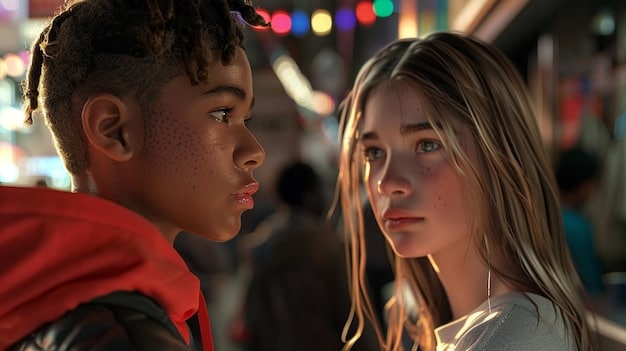Unveiling the Allure of Teen & Young Adult Dramas: A Deep Dive

Teen and Young Adult (YA) dramas captivate audiences with relatable characters, compelling storylines, and exploration of universal themes like love, identity, and belonging, often mirroring the challenges and triumphs of adolescence and young adulthood.
Teen and Young Adult (YA) dramas have become a prominent force in entertainment, captivating audiences of all ages. But what is it about these shows that makes them so addictive? We explore the allure of teen & young adult dramas, examining their themes, characters, and cultural impact.
The Enduring Popularity of Teen Dramas
Teen dramas have been a staple of television and film for decades, evolving with each generation to reflect the changing concerns and aspirations of young people. Their enduring popularity stems from their ability to tap into the universal experiences of youth, such as first love, identity formation, and navigating social hierarchies.
These dramas often tackle complex issues that resonate with young viewers, providing a platform for discussion and understanding. Whether it’s exploring mental health, addiction, or social injustice, teen dramas can be a powerful tool for raising awareness and promoting empathy.
Relatable Characters and Storylines
One of the key ingredients to a successful teen drama is its ability to create relatable characters that viewers can connect with. These characters are often flawed and imperfect, making them all the more human and engaging. Their struggles and triumphs mirror the challenges and aspirations of young audiences, fostering a sense of connection and empathy.
Similarly, the storylines in teen dramas are often grounded in reality, exploring themes that are relevant to the lives of young people. From navigating first love and heartbreak to dealing with family issues and academic pressure, these shows offer a glimpse into the complex and often tumultuous world of adolescence.
- Exploration of identity and self-discovery
- Portrayal of diverse relationships and friendships
- Addressing social issues and cultural trends
- Offering escapism and entertainment

Ultimately, the popularity of teen dramas lies in their ability to connect with audiences on an emotional level, providing a space for them to explore their own experiences and feelings. By offering relatable characters, compelling storylines, and a platform for discussion, these shows have become a vital part of the entertainment landscape.
Evolving Themes in YA Dramas
As society evolves, so do the themes explored in teen and young adult dramas. Early teen dramas often focused on more lighthearted topics like school dances and puppy love. However, contemporary YA dramas delve into much darker and more complex issues, reflecting the realities of modern adolescence.
These evolving themes allow the genre to remain relevant and engaging, attracting new audiences and keeping long-time viewers invested. By addressing timely and important issues, YA dramas can spark conversations and promote understanding.
Mental Health and Well-being
Mental health has become an increasingly prominent theme in YA dramas. Shows like “Euphoria” and “13 Reasons Why” have tackled issues like depression, anxiety, and addiction head-on, sparking important conversations about mental health awareness and treatment. While these shows have faced criticism for their sometimes graphic portrayal of these issues, they have also been praised for their willingness to address them openly.
By normalizing conversations about mental health, YA dramas can help reduce stigma and encourage young people to seek help when they need it. These shows can also provide a sense of community and support for viewers who are struggling with their own mental health challenges.
Social Justice and Activism
Many contemporary YA dramas explore themes of social justice and activism, reflecting the increasing awareness and engagement of young people in social and political issues. Shows like “The Hate U Give” and “Dear White People” address issues like racial inequality, police brutality, and systemic discrimination. These dramas often feature characters who are actively involved in fighting for social justice, inspiring viewers to take action in their own communities.
- Exploration of intersectionality and identity politics
- Portrayal of diverse perspectives and experiences
- Promotion of empathy and understanding
- Encouragement of civic engagement and activism
By tackling complex and controversial issues, YA dramas can challenge viewers to think critically about the world around them and inspire them to become agents of change. These shows can also provide a platform for marginalized voices to be heard, amplifying their stories and experiences.
Iconic Characters and Performances
The success of a teen drama often hinges on the strength of its characters and the performances of its actors. Over the years, many iconic characters have emerged from the genre, becoming cultural touchstones and inspiring generations of viewers. These characters are often complex and nuanced, with flaws and vulnerabilities that make them all the more relatable.
The actors who portray these characters often deliver memorable performances that capture the essence of adolescence and young adulthood. Their portrayals can be both heartbreaking and inspiring, leaving a lasting impact on viewers.
Breakout Stars and Career Launchpads
Teen dramas have served as a launchpad for many successful actors, providing them with the opportunity to showcase their talent and build a fanbase. Actors like Leonardo DiCaprio, Claire Danes, and Ryan Gosling all got their start in teen dramas, using the platform to launch their careers in film and television.
These breakout stars often bring a fresh perspective and raw talent to their roles, capturing the attention of both audiences and critics. Their performances can elevate a teen drama from a simple entertainment to a cultural phenomenon.
Many iconic characters from teen dramas have left a lasting impact on popular culture, influencing fashion, music, and even social attitudes. Characters like Cher Horowitz from “Clueless” and Regina George from “Mean Girls” have become synonymous with their respective eras, their style and personalities constantly referenced and parodied.
- Influence on fashion and beauty trends
- Impact on language and slang
- Reflection of cultural values and anxieties
- Creation of memorable catchphrases and quotes

The enduring legacy of these iconic characters is a testament to the power of teen dramas to shape and reflect popular culture. Their stories and performances continue to resonate with viewers, reminding us of the universal experiences of youth and the enduring power of storytelling.
The Influence of Streaming Services
The rise of streaming services has had a profound impact on the landscape of teen and young adult dramas. Platforms like Netflix, Hulu, and Amazon Prime have invested heavily in creating original YA content, offering viewers a wider range of choices and a more diverse selection of stories.
This influx of new content has led to a golden age of YA dramas, with shows that are more sophisticated, daring, and representative than ever before. Streaming services have also allowed for more creative freedom, giving showrunners the opportunity to experiment with different formats and storytelling techniques.
Binge-Watching Culture and Social Media
The binge-watching culture popularized by streaming services has transformed the way viewers consume teen dramas. Instead of waiting a week for each new episode, viewers can now watch an entire season in a single sitting. This has led to a more immersive and engaging viewing experience, allowing viewers to become fully invested in the characters and storylines.
Social media has also played a significant role in shaping the viewing experience of teen dramas. Viewers can now connect with other fans online, sharing their thoughts, theories, and reactions to the show. This creates a sense of community and allows viewers to feel like they are part of something bigger.
- Increased accessibility and convenience
- Greater diversity and representation
- More creative freedom and experimentation
- Enhanced viewer engagement and interaction
The combination of streaming services, binge-watching culture, and social media has created a perfect storm for the success of teen and young adult dramas. These shows are now more popular and influential than ever before, shaping the cultural landscape and connecting with viewers in new and meaningful ways.
Criticisms and Controversies
Despite their popularity and cultural impact, teen and young adult dramas have also faced their share of criticisms and controversies. Some critics argue that these shows often glamorize or sensationalize sensitive topics like mental health, drug use, and sex, potentially leading to negative consequences for young viewers.
Others argue that teen dramas often perpetuate harmful stereotypes and unrealistic expectations about relationships, body image, and social status. While these criticisms are valid, it’s important to remember that teen dramas are often intended to be entertaining and thought-provoking, not necessarily realistic or educational.
Responsibility and Representation
One of the main concerns surrounding teen dramas is the responsibility they have to accurately and ethically represent sensitive topics. Shows that deal with issues like mental health and addiction have a particular obligation to portray these issues in a responsible and informative way, avoiding sensationalism or glamorization.
Similarly, teen dramas have a responsibility to portray diverse characters and experiences, avoiding harmful stereotypes and promoting inclusivity. This includes representing different races, ethnicities, sexual orientations, and socioeconomic backgrounds.
Addressing criticisms and controversies related to teen dramas can lead to more thoughtful and responsible storytelling. By acknowledging the potential negative impacts of these shows, creators can work to mitigate those risks and create content that is both entertaining and socially conscious.
- Promoting media literacy and critical thinking
- Encouraging open dialogue about difficult topics
- Providing resources and support for viewers who are struggling
- Creating content that is both entertaining and responsible
Ultimately, the key to creating successful and responsible teen dramas is to engage in an open and honest dialogue with viewers, critics, and experts. By listening to different perspectives and taking criticism seriously, creators can work to create content that is both entertaining and socially responsible.
The Future of Teen & Young Adult Dramas
The future of teen and young adult dramas looks bright, with new platforms and technologies constantly emerging to offer viewers even more choices and opportunities for engagement. As the genre continues to evolve, it is likely to become even more diverse, inclusive, and socially conscious.
The rise of interactive storytelling and virtual reality could also revolutionize the way viewers experience teen dramas, allowing them to become active participants in the story and connect with characters on a deeper level.
Interactive Storytelling and Virtual Reality
Interactive storytelling is a growing trend in the entertainment industry, allowing viewers to make choices that affect the outcome of the story. This could be particularly appealing for teen dramas, as it would allow viewers to explore different perspectives and relationships, and even create their own personalized storylines.
Virtual reality could also transform the way viewers experience teen dramas, allowing them to step into the shoes of their favorite characters and explore the world of the show in a more immersive and engaging way. Imagine being able to attend a party at the school, visit the characters’ homes, or even participate in a romantic encounter.
As teen and young adult dramas continue to evolve, they are likely to become an even more powerful and influential force in popular culture. By reflecting the changing concerns and aspirations of young people, these shows can provide a platform for discussion, understanding, and connection.
- Increased diversity and representation
- More interactive and immersive experiences
- Greater focus on social issues and activism
- Continued innovation and experimentation
Whether it’s through traditional television, streaming services, or emerging technologies, teen and young adult dramas are sure to remain a vital part of the entertainment landscape for years to come.
| Key Topics | Brief Description |
|---|---|
| 💖 Relatable Characters | Characters reflect real-life teen issues. |
| 🎭 Evolving Themes | Themes tackle mental health and social justice. |
| 🚀 Streaming Influence | Streaming boosts diversity and creative freedom. |
| 🌟 Iconic Performances | Memorable roles shape pop culture. |
Frequently Asked Questions
▼
Teen dramas are popular because they tackle universal themes like identity, love, and belonging. They often feature relatable characters facing challenges that resonate with young audiences. The dramas also sometimes highlight topics such as social justice, mental health awareness, and self-discovery.
▼
A successful teen drama needs relatable characters with compelling storylines and relevant themes. Good writing, strong performances, and addressing current social issues can set a teen drama apart, giving it resonance within the pop culture discourse. Shows that allow viewers to see themselves within the struggles of the characters can have immense popularity.
▼
Streaming services have revolutionized teen dramas by increasing creative freedom and diversity. Platforms like Netflix and Hulu have invested in original YA content, showcasing diverse stories. Binge-watching and social media interactions enhance engagement, allowing deeper involvement and a quicker cultural explosion.
▼
Criticisms often focus on the glamorization of sensitive and controversial topics. Over-representation, especially portraying stereotypical roles and harmful expectations regarding relationships and/or body image, may be problematic. Responsible and accurate representations are constantly a key area of concern.
▼
The future involves more diversification and the use of interactive storytelling to create further immersive narratives. Immersive virtual reality and storytelling technologies that enable personalized storylines are likely to shape the future, along with a much bigger emphasis on tackling social justice concerns and societal activism.
Conclusion
Teen dramas continue to evolve, reflecting the challenges and triumphs of young people in an ever-changing world. By providing relatable characters, compelling storylines, and a platform for discussion, these shows will continue to captivate audiences and shape popular culture.





